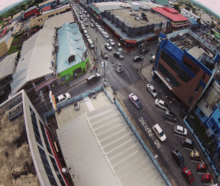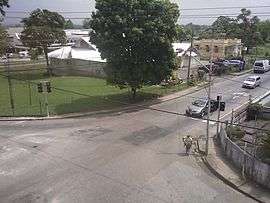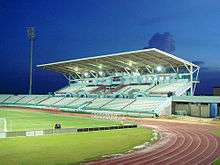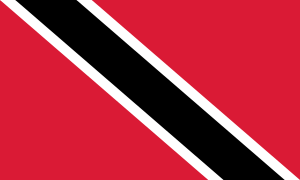Arima
| Arima, Trinidad and Tobago | |
|---|---|
| Borough of Trinidad and Tobago | |
| The Royal Chartered Borough of Arima | |
|
Aerial view of the Central Business District of Arima, Trinidad & Tobago | |
| Coordinates: 10°37′N 61°16′W / 10.617°N 61.267°WCoordinates: 10°37′N 61°16′W / 10.617°N 61.267°W | |
| Country |
|
| Metro Area | East-West Corridor |
| County | Saint George County |
| Royal Borough | August, 1888 |
| Government | |
| • Mayor | His Worship Alderman George Hadeed |
| • Governing body | Arima Borough Corporation |
| Area | |
| • Total | 12 km2 (5 sq mi) |
| Population (2011) | |
| • Total | 33,606[1] |
| • Density | 2,801/km2 (7,250/sq mi) |
| Time zone | Atlantic (UTC-4) |
| Area code(s) | 664, 667 |
| Website |
www |
|
| |
Arima is the easternmost and second largest in area of the three boroughs of Trinidad and Tobago. It is geographically adjacent to Sangre Grande and Arouca at the southcentral foothills of the Northern Range, and to the south is the Caroni-Arena Dam; in addition, Coterminous with Town of Arima since 1888, the borough of Arima is the fourth-largest municipality in population in the country (after Port of Spain, Chaguanas and San Fernando), with a census-estimated 33,606[1] residents in 2011.
The town petitioned Queen Victoria for municipal status as part of her Golden Jubilee in 1887. This was granted in the following year, and Arima became a Royal Borough on 1 August 1888. Historically, the third town of Trinidad and Tobago, Arima has slid into fourth place as Chaguanas became the largest town in the country.
Geography
Climate
The borough has a tropical wet and dry climate (Köppen Aw) climate characterized with little seasonal variations due to its close proximity to the Northern Range. Temperatures typically range from 19 to 33 degrees. The wet season lasts from June to November and the dry season lasts from December to May of the following year. Hail has occurred in the town but is rare.
Culture and entertainment

Arima hosts an annual Borough Day anniversary celebration in August. The celebration incorporates Carnival-style street parades and usually coincides with the staging of the Santa Rosa Carib Community annual festival. The annual Arima Carnival includes street parades of masqueraders on Carnival Tuesday, J'ouvert bands on Carnival Monday, as well as a local calypso competition. The calypsonian Lord Kitchener (1922–2000) was a favoured son of Arima. His remains are interred in the Santa Rosa Roman Catholic Cemetery, Arima. National Icon Holly Betaudier (aka The Arima Kid) was also born in the borough of Arima. He started his career in radio at the US Armed Forces radio service network in 1946. Due to his love for culture and the arts he founded and hosted the first televised talent show titled "Scounting for Talent". This television show discovered many artist in the genre of calypso and parang and was a favorite of many families. Up until his passing on May 30, 2016 at the age of 91 Mr. Betaudier hosted his radio programme titled "Toute Bagai" (a Patios expression meaning "everything), which was a platform for him to proudly speak one of the dying languages of Trinidad. Footballer Clayton Ince was also born in the town.
Transportation
Airports
The main international and domestic airport serving Arima is Piarco International Airport which lies 11 km (7 mi) west of Arima The town is also host to a small airfield in Wallerfield, a neighborhood in West Arima just about 10 km (6.2 mi) west of the town Central Business District.
Highways and roads

The major land transportation arteries are the Churchill Roosevelt Highway, Eastern Main Road and the Priority Bus Route which all link Arima with major towns and cities along the East-West Corridor Metropolitan Area. Among other important routes are the Arima Bypass, Tumpuna Road and O'Meara Road which links neighborhoods around the town to the Town Center.
Transit
Arima plays an important role for North Eastern Trinidad as it is a Multi Modal Transportation Hub for much towns on the East Coast and neighbourhoods. The hub also features a bus terminal providing service by the PTSC Bus network to Sangre Grande, Mundo Nuevo, Blanchisseuse, Carapo, Malabar, Morne La Croix, La Horquetta, Brasso Seco and to the capital Port of Spain. Alongside the Bus service there is the Maxi taxis which are private, owner-operated minibuses in throughout Trinidad and Tobago that are used in public transport. They operate along fixed routes, having fixed fares and meeting points. However they do not operate under a timetable. They provide services from the town center to Port of Spain and stop along the East-West Corridor as well as to Sangre Grande.
Sports

The Borough of Arima is home to a major national super league teams, FC Santa Rosa and Arima Football League of which is based at the Arima Velodrome.
Abilene Wildcats Athletic Club, Trinity College East Athletics Club, Silver Bullets Athletic Club, D'Abadie Progressive Athletic Club, and Spartans High Speed Performance Athletic Club are also based in Arima.
Most suburbs, communities and neighborhoods around the Borough also have their own sporting complexes and community swimming pools.
The three (3) major sporting arena's in Arima are.
- The Larry Gomes Stadium
- Arima Velodrome
- Santa Rosa Race Track
Attractions
Located in Arima Valley, has a nature walk and swimming at a freshwater pond.
- Santa Rosa Carib Centre
Located on Paul Mitchell Road, off of De Gannes Street in Arima, contains items from Arima's native history, and has displays of descendants of the Caribs in Arima. Native items also available for purchase.
- Cleaver Woods
Has nature walks and Amerindian exhibits.
Utilities
Electric generation is handled by Powergen, while electrical distribution is handled by the Trinidad and Tobago Electricity Commission (T&TEC). Powergen has natural gas fired generation plants at Point Lisas, Penal, and Wrightson Road in Port of Spain. Additional power can be supplied from power generation facilities controlled by Inncogen at Point Lisas.
Telecommunications are regulated by the Telecommunications Authority of Trinidad and Tobago (TATT). It has been working to de-monopolise the industry, granting several new licenses in 2005. Fixed-line telephone service is a monopoly controlled by Telecommunications Services of Trinidad and Tobago (TSTT). Licenses have been granted for competition in this area, but start-up is a while away. Wireless telephony is currently controlled by TSTT and bmobile as well as Digicel which came later. Licenses have been granted for a private company, Laqtel, to offer wireless service in competition with TSTT and Digicel. However, Laqtel has had its license revoked, and is undergoing severe financial difficulties.
Digital cable television is provided by Flow. High speed internet service of up to 100Mbit/s and digital landline telephone service are all available in Arima.
Water and sewerage are under the purview of the Water and Sewerage Authority of Trinidad and Tobago (WASA).
Education
There are several primary (private and public) and secondary educational institutions in Arima, and some post-secondary level technical training institutes. St. Joseph's Convent in Arima was closed many years ago and the building now houses a retreat centre called Emmaus Centre.
Schools
Primary
- Arima Hindu Primary School
- Arima Boys' Government Primary School
- Arima Boys' R.C. Primary School
- Arima Centenary Government Primary School
- Arima Girls' Government Primary School
- Arima Girls' R.C. Primary School
- Arima New Government Primary School
- Arima Presbyterian Primary School
- Arima West Government Primary School
- Christian Primary Academy
- EdenWay Pre-Primary Christian School
- Giuseppi Preparatory
- Malabar Government Primary School
- Malabar R.C. Primary School
- New Dawn Preparatory
- Santa Rosa Government Primary School
- St. Hilary's Preparatory
Secondary
- Arima Government Secondary School
- Arima Senior Comprehensive (now Arima North Secondary School)
- Holy Cross College
Post-secondary Institutions
- Ambi's Career Institute
- College of Professional Studies
- Zenith Educational Institute
Gallery
-

Bus terminal
-

Arima Velodrome
-

Arima Velodrome
-

Eastern Main Road
References
- 1 2 "Trinidad and Tobago 2011 Census" (PDF). Ministry of Planning and Sustainable Development. November 30, 2012.
- Anthony, Michael (2001). Historical Dictionary of Trinidad and Tobago. Scarecrow Press, Inc. Lanham, Md., and London. ISBN 0-8108-3173-2.
External links
- Arima Borough Corporation Official website
- Articles from Nalis marking Arima's 112th anniversary as a borough.
- Article from Nalis marking Arima's 109th anniversary as a borough.
- Some pictures of Arima from TriniView.com showing many streets.
- Cleaver Woods at wcities.com
- Santa Rosa Carib Community
- Newsday: Arima Carnival Results
- Guanaguanare - the Laughing Gull. Carib Indians in Trinidad - includes 2 videos

